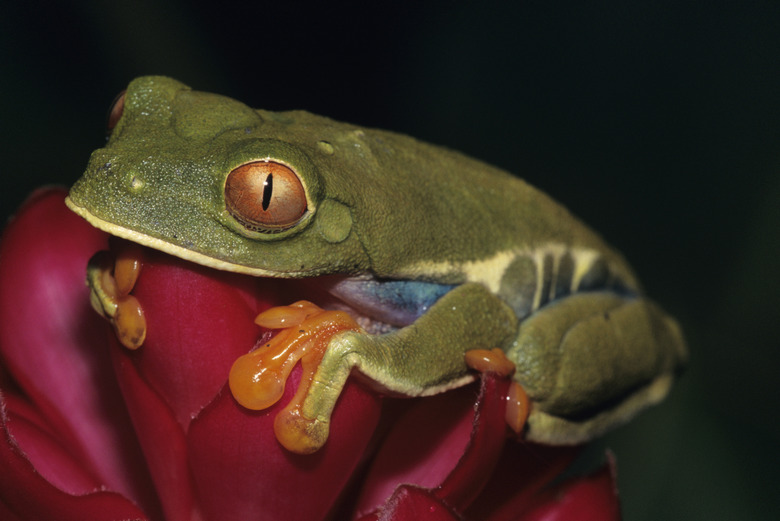How To Compare The Biodiversity Of Temperate Forest Biomes With Tropical Forest Biomes
Biodiversity — the degree of genetic and species variability among organisms — in an ecosystem depends, in great part, on how hospitable that ecosystem is to life. It can vary greatly based on climate, geography and other factors. Ample sunlight, consistently warm temperatures and frequent, abundant precipitation — all plentiful in tropical rainforests — tend to produce highest biodiversity among ecosystems.
Comparing Biodiversity
Comparing Biodiversity
Tropical forests, including evergreen rainforests, cloud forests, seasonal deciduous forests and mangrove forests, have the highest biodiversity of all terrestrial biomes. Tropical rainforests, in particular, cover less than 7 percent of the Earth's surface but harbor an estimated half of all existing plant and animal species. A small plot can yield hundreds of tree species – as many as all North American temperate and boreal forests combined — and one reserve in Peru has more than 1,200 different butterflies. Dry tropical forests contain some of the same species as rainforests but fewer species overall. Among the major temperate forest types (temperate coniferous, rainforest, deciduous and mixed forests), temperate deciduous and mixed forests — which include both deciduous and coniferous species — have the highest biodiversity. Some temperate coniferous forests consist of only a few tree species, but the chatter and songs of great varieties of birds often fill their borders.
Geography and Climate as Factors in Biodiversity
Geography and Climate as Factors in Biodiversity
Primarily found within 28 degrees of the equator, all tropical forests experience consistently warm temperatures and strong and fairly uniform solar radiation year-round. Tropical rainforests benefit additionally from frequent and abundant rain, averaging six to 30 feet per year. All of these factors favor a multitude of invertebrates — some estimates say as many as 30 million species — as well as amphibians, reptiles, plants and other organisms that thrive in warm weather and available water. Temperate forests, usually found between 37 and 60 degrees latitude, experience cool-to-cold and warm-to-hot seasons as well as seasonally varied solar radiation and day length. Where precipitation is regular year round, deciduous forests dominate; drier coniferous forests, with their summer drought periods, have more limited biodiversity. Lush temperate rainforests, however, are also primarily coniferous. They experience more moderate seasons and high precipitation — except during summer droughts — because of their proximity to ocean and mountain range, and they possess the highest biomass of any forest ecosystem. For all temperate forests, cold to sub-freezing winter temperatures limit their biodiversity — especially the diversity of cold-blooded species. Seasonal leaf drop in tropical dry and temperate deciduous forests and an extensive dry season in tropical dry forests also limit their productivity and biodiversity.
Evolutionary History as a Factor in Biodiversity
Evolutionary History as a Factor in Biodiversity
Another reason for the unusually high biodiversity in tropical rainforests may be their long evolutionary history. Thought to have existed roughly 60 million years, rainforests may have been relatively unaffected by glaciation and climactic shifts of the last glacial maximum (LGM) compared to other ecosystems on Earth. In contrast, mixed temperate deciduous forests and coniferous forests were pushed further south during the LGM and much reduced in size. Temperate rainforests were at one time dominated by deciduous trees, before summer dry seasons pushed most of them out. With climate changes, ecosystems often suffer at least a temporary loss of species. Tropical rainforest species have been able to evolve for longer periods of time, adapting to many specialized niches.
Niche Specialization as a Factor in Biodiversity
Niche Specialization as a Factor in Biodiversity
Niche specialization may be another factor in biodiversity. The massive trees and multiple canopy layers in tropical rainforests, as well as varied habitats offered by geological features such as mountains, encourage the development of niche specialization, resulting in the evolution of new species. Some arboreal animals, living at specific elevations in tropical rainforest canopies, never touch the ground during their lifetime. Coniferous forests tend to have fewer forest layers — sometimes only two — and therefore less niche specialization, although some pine forests feature a shrub layer. Multiple layers in temperate deciduous forests contribute to niche partitioning and higher biodiversity there as well. The rough pattern that seems to emerge in tropical and temperate deciduous forests is as follows: the taller the trees, the more the layers, the more the niches and the more the species.
References
- Encyclopedia of Life: Biodiversity
- Scitable by Nature Education: Terrestrial Biomes
- McGraw-Hill Higher Education: Kinds of Ecosystems and Communities
- Smithsonian Tropical Research Institute: Rainforests: Diversity and Survival
- Marietta College Department of Biology and Environmental Science: Biomes of the World
- The University of Michigan's Global Change Program: The Tropical Rainforest
- National Park Service: Olympic National Park: Temperate Rain Forests
- Marietta College: The Tropical Rainforest
- Green Facts: Comparisons for the 14 Terrestrial Biomes of the World in Terms of Species Richness, Family Richness, and Endemic Species
Cite This Article
MLA
Carter, Kari Norborg. "How To Compare The Biodiversity Of Temperate Forest Biomes With Tropical Forest Biomes" sciencing.com, https://www.sciencing.com/compare-biodiversity-temperate-forest-biomes-tropical-forest-biomes-12326318/. 24 April 2017.
APA
Carter, Kari Norborg. (2017, April 24). How To Compare The Biodiversity Of Temperate Forest Biomes With Tropical Forest Biomes. sciencing.com. Retrieved from https://www.sciencing.com/compare-biodiversity-temperate-forest-biomes-tropical-forest-biomes-12326318/
Chicago
Carter, Kari Norborg. How To Compare The Biodiversity Of Temperate Forest Biomes With Tropical Forest Biomes last modified August 30, 2022. https://www.sciencing.com/compare-biodiversity-temperate-forest-biomes-tropical-forest-biomes-12326318/
